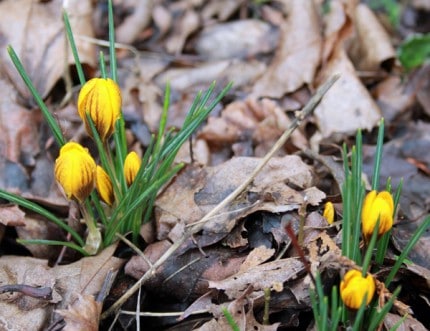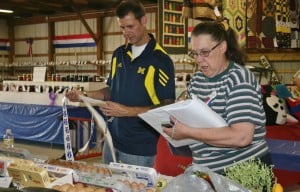
By Jennifer Fairfield, owner The Garden Mill
All that sunshine we got last week – along with the warmer temperatures – has me anxious to get out in my garden.
I know it’s not really time to do much out there just yet, but I can’t help wanting to. I’m like a kid standing outside a candy store that doesn’t open for another 10 minutes.
While we try to be patient, since it’s not quite gardening weather yet, there are some things to do to get ready for gardening season.
Indoors:
Take stock of what you have, and make a list of what you need, then start looking for it now. One thing to keep in mind this year is that the supply chain for almost everything is still under great strain from the pandemic.
We are getting updates weekly from our vendors on what is and isn’t going to be coming in, and many manufacturers are having problems keeping up. That doesn’t necessarily mean we won’t be getting things in, but it may mean that we get different brands of items than we usually have, that we don’t get as much as we want, or that things come in slowly, over time. So, check in regularly with us. If you don’t see something you are looking for, ask.
We may be able to tell you when it’s due in, or to suggest substitutes.
If you are planning to start your own plants from seed, this is the month to do a lot of that. Starting your own plants can be a great way to save money, and it’s a wonderful thing to do with your kids. I’ve included a chart with information on when to start some things indoors below.
If you’re new to the idea of starting plants, there are a number of things to keep in mind, including when to start, how warm the soil should be, and how much light the seedlings need. If you’d like some more details about all of that, email me at [email protected], and I’ll be happy to send that to you. I am also happy to answer questions, so don’t hesitate to ask, if you’re in the store.
While we’ve sold out of some varieties, we do still have lots of seeds at The Garden Mill! And, they’re on sale (along with seed starting supplies) throughout the month of March.
While I don’t have a chart for flowers like I do for vegetables, many flowers can be started from seed, too. Just a few include Zinnia, nigella, stock, and thunbergia. Start zinnias now. Most others get started in mid-March, while the end of the month is the time to start Echinacea seeds.
If you didn’t get to it last month, re-pot any of your indoor plants that need it. Now is also the time to start fertilizing indoor plants again, after letting them rest over the winter.
Tender bulbs, such as dahlias, that were stored over the winter, should be checked now for any that are soft, damaged, or diseased. Those should be tossed.
Depending on the variety and when you potted them, bulbs potted for forcing last fall could be getting ready to start coming up this month. When your bulbs get a few inches of growth, it’s time to move them into a cool (60 degrees) sunny spot, but not in direct sunlight. Once they have flowered, move them into a warmer spot, but keep them out of direct sunlight to help the blooms last longer. For even longer lasting blooms, provide cooler nighttime temperatures.
Outdoors:
If you didn’t get pruning done last month, you can still do some pruning yet, but understand some of the challenges.
First, some trees pruned when it’s warmer out are vulnerable to insects and disease that are active in warmer weather. Except to trim away dead, damaged, or diseased wood. Oaks are one tree that should only ever be pruned in the dead of winter.
Second, trimming now could stimulate new growth as the trees and shrubs come out of dormancy. This could leave the new growth in danger if we get a late cold snap.
Third, many trees and shrubs that bloom in the summer produce flowers from new wood, so pruning after they start to grow can keep them from flowering this year.
Fourth, trees and shrubs that bloom before mid-June produce blossoms on wood from last year’s growth, so should only be pruned after they have finished blooming.
There is one reason to prune some early-blooming trees and shrubs now – to force branches into bloom indoors. Take some cuttings from shrubs and trees, such as forsythia, cherry, quince, and redbud, and bring them indoors. Trim the ends, using long, slanted cuts to help the branches take up water. Place the branches in vases of water, and change the water every few days.
Depending on the variety, blooming can happen as quickly as one to two weeks, though some can take as much as five weeks.
For more information on how and what to force into bloom, check out this article from Purdue University’s Extension Service.
Frost heave can still be an issue this month, so keep an eye out, if you are out in your yard. Frost heave occurs when wet soil freezes and expands, pushing roots up, out of the soil. If you find this happening to your plants, gently press them back down to prevent damage to the roots and plant. Then give the plant a good layer of mulch to protect from the thaw and re-freeze cycles that we are likely to see yet.
This may sound contradictory to telling you to go out and prune and fix frost heave issues, but try to stay off the lawn and out of garden beds as much as possible if the soil is wet and soft, which it definitely is right now, because wet, soft soil is easily compacted by walking on it at this time, and compacted soil is very difficult for anything to grow in.
It may be tempting to simply start applying fertilizers to your lawn and flower beds when spring gets going, and you’re ready to plant. Before you do that, it’s a really good idea to do a soil test.
Soil tests help you know what your plants and lawn really need, so that you aren’t wasting money on the wrong fertilizers. Do that test now, so you’re ready to go when spring really gets going. We carry a very good at-home test kit at the store, or you can send away for a more comprehensive test kit from the MSU extension.
Just as it’s important to grow seeds indoors at the proper soil temperature, it also important to know the soil temperature outdoors, before you begin to plant things. For instance, most of us know that peas grow in the early spring, but do you know exactly when you should plant them? Some people say peas should be planted in March – as early as Saint Patrick’s Day.
That’s just silly most years, here in Southeast Michigan. But, it’s not absolutely out of the question – it all depends on the soil temperature. Every seed has a range of soil temperatures that are just right for germination. For peas, the range is 40° to 85°, with 75° being ideal.
The Extension Service at The University of California has a really good soil temperature chart for seed germination of lots of different vegetable plants. To take your soil’s temperature, you need a soil thermometer – which you can, of course, find at The Garden Mill.
For the birds:
If you don’t feed the birds all year long, like I do, don’t stop feeding them yet – the options for food in nature are really slim for birds at this point, because there are few insects out yet, and much of the seeds and berries from last year have been consumed by now. If we get some prolonged freezing temperatures again, which is certainly still possible, giving them some access to fresh water can be life-saving.
A heated birdbath or a de-icer in a birdbath can provide that. These products won’t run during times when the temperature is high enough that the water doesn’t freeze, because they have thermostats in them. So, you aren’t wasting electricity by leaving them out and plugged in at this time of year.
Clean out nest boxes, or put up new ones (or both). Many birds will begin to scout out nesting sites this month, so cleaning out existing houses or putting up new ones now will encourage them to take up residence in your yard – they’ll return the favor by feeding their young with insects from your yard this spring!
One good thing that has come out of the pandemic is that there are a number of events that used to be only held in-person, but are now available virtually.
This includes a number of classes from the Michigan Audubon Society, with a variety of topics. One coming up this month is about Purple Martins, where you can learn all about how to provide the perfect home for these beautiful birds, that are in decline in Michigan.
Learn about that event and others at this website.
























